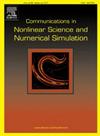Efficient numerical schemes for the conserved Allen-Cahn phase-field surfactant system based on high order supplementary variable method
IF 3.8
2区 数学
Q1 MATHEMATICS, APPLIED
Communications in Nonlinear Science and Numerical Simulation
Pub Date : 2025-07-02
DOI:10.1016/j.cnsns.2025.109094
引用次数: 0
Abstract
Numerous accurate, efficient, and robust numerical schemes for phase-field surfactant models have been developed, with those ensuring energy stability being particularly attractive. Unconditional energy stability refers to numerical stability without any restrictions on the time step size. Recent research has concentrated on methods such as convex splitting, invariant energy quadratization (IEQ), scalar auxiliary variable (SAV), and Lagrange multiplier methods, which are generally unconditionally energy stable but mostly guarantee modified energy dissipation and are second-order accurate in time. This is often insufficient to meet the high-precision demands of long-term simulations. This paper presents a class of high-order numerical schemes based on the supplementary variable method (SVM) combined with the Runge–Kutta (RK) method. These schemes preserve the original energy dissipation law and can achieve arbitrarily high-order time accuracy. Benchmark numerical examples are provided to illustrate the accuracy and efficiency of these schemes.
基于高阶补充变量法的守恒Allen-Cahn相场表面活性剂体系的有效数值格式
许多相场表面活性剂模型的精确、高效和稳健的数值方案已经开发出来,那些确保能量稳定性的方案特别有吸引力。无条件能量稳定性是指不受时间步长限制的数值稳定性。近年来的研究主要集中在凸分裂、不变能量二次化(IEQ)、标量辅助变量法(SAV)和拉格朗日乘子法等方法上,这些方法通常是无条件能量稳定的,但大多保证修正能量耗散,并且在时间上是二阶精确的。这往往不足以满足长期模拟的高精度要求。提出了一类基于补充变量法(SVM)和龙格-库塔法(RK)相结合的高阶数值格式。这些方案保留了原有的能量耗散规律,并能达到任意高阶时间精度。通过数值算例验证了所提方法的准确性和有效性。
本文章由计算机程序翻译,如有差异,请以英文原文为准。
求助全文
约1分钟内获得全文
求助全文
来源期刊

Communications in Nonlinear Science and Numerical Simulation
MATHEMATICS, APPLIED-MATHEMATICS, INTERDISCIPLINARY APPLICATIONS
CiteScore
6.80
自引率
7.70%
发文量
378
审稿时长
78 days
期刊介绍:
The journal publishes original research findings on experimental observation, mathematical modeling, theoretical analysis and numerical simulation, for more accurate description, better prediction or novel application, of nonlinear phenomena in science and engineering. It offers a venue for researchers to make rapid exchange of ideas and techniques in nonlinear science and complexity.
The submission of manuscripts with cross-disciplinary approaches in nonlinear science and complexity is particularly encouraged.
Topics of interest:
Nonlinear differential or delay equations, Lie group analysis and asymptotic methods, Discontinuous systems, Fractals, Fractional calculus and dynamics, Nonlinear effects in quantum mechanics, Nonlinear stochastic processes, Experimental nonlinear science, Time-series and signal analysis, Computational methods and simulations in nonlinear science and engineering, Control of dynamical systems, Synchronization, Lyapunov analysis, High-dimensional chaos and turbulence, Chaos in Hamiltonian systems, Integrable systems and solitons, Collective behavior in many-body systems, Biological physics and networks, Nonlinear mechanical systems, Complex systems and complexity.
No length limitation for contributions is set, but only concisely written manuscripts are published. Brief papers are published on the basis of Rapid Communications. Discussions of previously published papers are welcome.
 求助内容:
求助内容: 应助结果提醒方式:
应助结果提醒方式:


